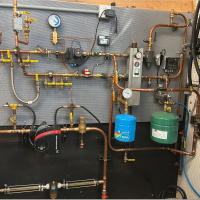Best Of
Re: Viessmann mixing valve threads I.D. too large
I installed a Viessmann indirect/ solar tank recently it came with BSP to NPT adapters in the box, up to 1-1/2” size. So somewhere in their catalog must be adapter fittings?
Some connections depend on a fiber washer on the face to seal. Piping for boilers and fuel piping is generally done with hemp.
Caleffi machines hemp specific brass fittings. The threads get knurled so the hemp doesn’t roll off so easily.
When German boilers first started arriving in mass, they came with a fist full of hemp.
You know what that means to a young thrill seeking installer🫣
 hot_rod
hot_rod
Re: Navien NPE-180 keeps needing to be reset
Re: Primary Secondary Flow Direction
I just answered a question with a Similar problem where the return and the supply was reversed. His was trying to solve a different problem but offered the diagram in this post.
Here is the diagram as his system is installed. See the closely spaced tees and how they are reversed. I don't believe that he knows that reversing the supply and return like this is a problem. All he wanted is to solve is the noise issue.
First Diagram reposted here
Take a look at the second diagram and see how easy it would be to make yours look like that one. Disregard the DHW loop if you are not using an Indirect Water Heater.
Second Diagram reposted here
I offered the second diagram to resolve his noise problem and to correct the reversed piping on the closely spaced tees. See if your system can be repiped this way where the Expansion tank is located on the boiler loop supply side I understand that your boiler pump is internal to the boiler unlike this diagram, but all the parts are in the right order for noise free and trouble free operation
Single Pipe Steam Heat- Pipe Banging
For some reason, my pipes started banging in the walls. They seem to be sloped properly and the main valve works and on all the radiators as well. I did have a section of overflow return replaced. What is the best remedy to cure the banging, bleeding the boiler, drain the whole system?
Re: What kind of steam trap cage is this ?
@guzzinerd B&J site is saying use 1764 cage unit with existing cover. Where would i go about finding a new cap that will work it ?
 Jchenabc
Jchenabc
Re: What kind of steam trap cage is this ?
It will work with the cap (cover) you have now.
Re: Cold Weather Conundrum
Update: gas company came out to check the pressure. They checked water column and confirmed pressure is good. They also confirmed my clocking measurement which shows the boiler is severely under fired. They advised to get the gas control valve repaired or replaced asap, which is my next step.
Since it’s been running this way for a while I don’t see a reason not to keep running it to avoid pipes freezing for the next few days until I can get a plumber out, but if anyone thinks there’s a safety risk or further damage may occur I could try alternatives.
It’s possible that the valve has been downfired like this for a long time, but seems like something else is going on since the system is still struggling to get the house to 60 (outdoor high of 27 today).
15% efficiency improvement on Weil-McLain WGO-5 boiler
Thanks again to the many heating pros here who have given me lots of good advice on our Weil McLain WGO-5 oil boilers. These are cold-start boilers without DHW, which are very oversized and as a result run only about a 30% duty cycle on a design day. Heat is delivered via a 100-year-old gravity conversion high-mass hot water system with original cast iron radiators.
In an effort to improve efficiency and reduce oil consumption, I made the following changes at the start of this heating season on one boiler:
- Increased thermostat differential from 1.0 degrees to 1.5 degrees.
- Programmed a 3-degree overnight setback (previously had no setback)
- Added thermal post-purge to keep the circulator running until supply water temp reaches 90 degrees.
The objective of the first two thermostat changes was to lengthen the average boiler run time. Increasing the differential means the boiler has to run longer to make up a bigger temperature rise, and the setback eliminates some overnight boiler runs, causing a longer run in the morning. The result has been to increase average run time from around 30-40 minutes to around 50-60 minutes. In theory, this should increase efficiency. And the thermal post-purge keeps extracting residual heat from the boiler after shutdown.
Now that the heating season is halfway over, I've been able to compare run time data from our ecobee thermostat for a similar period last year, and divide the run times by the heating degree days for those periods to get an apples-to-apples comparison.
Last season's run time/HDD ratio was 6.72 minutes/HDD. With the above changes, this season's run time ratio is 5.72 minutes/HDD for the same period.
So the boiler is running only 85% as long per HDD this season vs last, which means a 15% decrease in oil consumption.
Since I made all three changes (increased differential, setback, and post-purge) at the same time, it's impossible to say how much difference each change made. But cumulatively the effect was considerable. I had been hoping for a 10% improvement, so 15% is a nice surprise.



